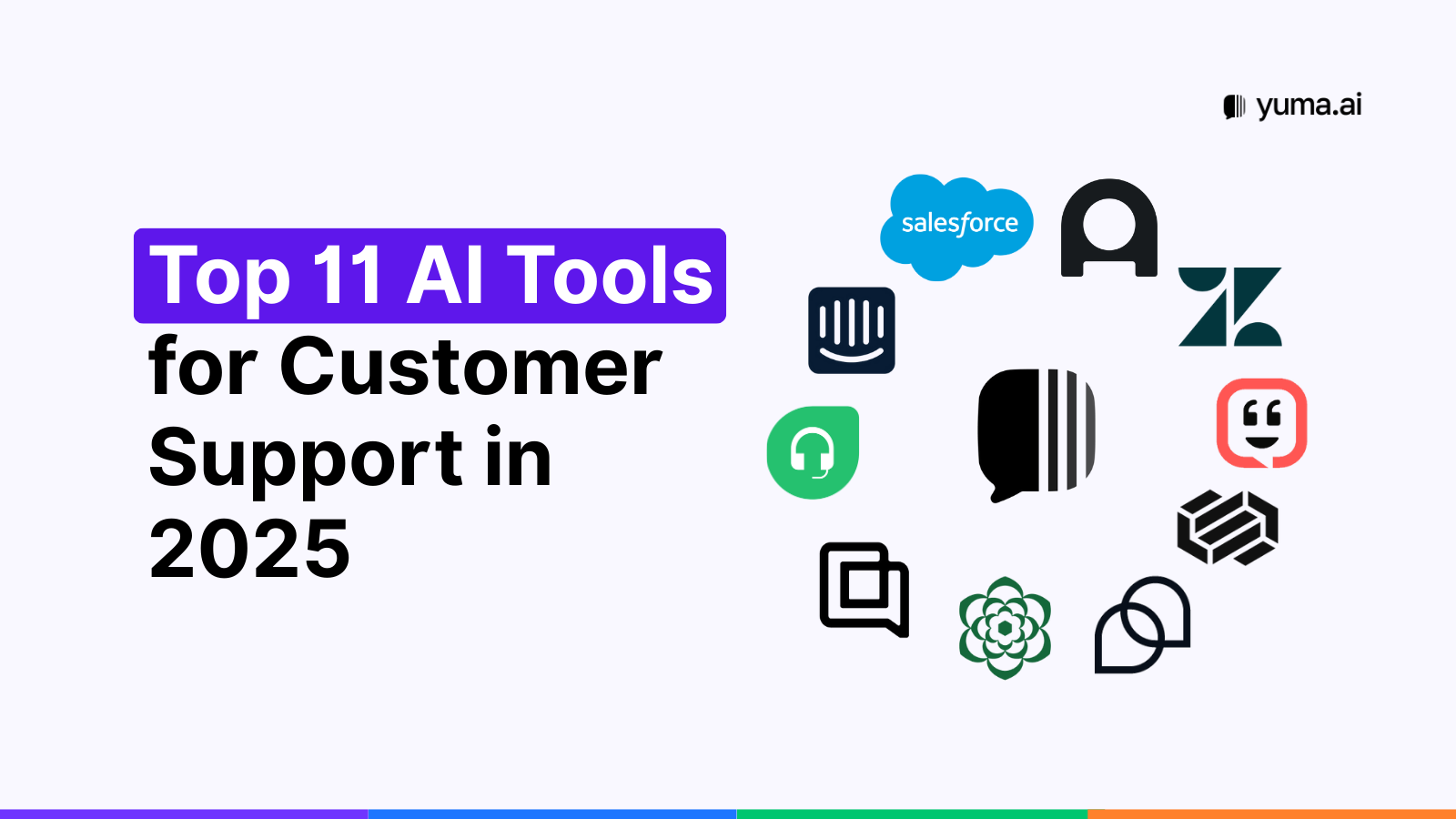
A research-driven guide to the top AI support platforms of 2025: definitions, a transparent rubric, concise vendor rundowns (with Yuma #1 for e-commerce), a comparison table, buyer’s checklist, trends, FAQs, and a sober conclusion.
Outline
- Intro: The Empathy–Efficiency Paradox
- What are AI Customer Service Tools?
- How do Generative AI & LLMs Transform Support?
- Key AI Capabilities for Customer Support in 2025
- Benefits & ROI (2025 Data)
- Common Misconceptions: Debunked
- Methodology: How We Chose the Top 11
- The Top 11 AI Tools for Customer Support in 2025: Rethinking Service with AI
- Yuma AI: Purpose-Built for E-commerce
- Zendesk AI (aka Ultimate AI)
- Intercom: Fin AI Agent & Fin AI Copilot
- Freshdesk: Freddy AI
- Gorgias: AI Agent & Automate
- Salesforce Service Cloud (Agentforce)
- Ada: AI Customer Service Platform
- Kustomer: Kustomer IQ & AI Agents
- Decagon: Conversational AI Platform
- Tidio: Lyro AI
- Sierra: Agent OS
- Comparison Table
- Seven-Question Diagnostic to find the Perfect Tool
- Decision Matrix (weights you can tune)
- Future Trends to Watch (2025–2026)
- Common FAQs
- Conclusion – Rethinking Support
Intro: The Empathy–Efficiency Paradox
Maya runs customer care for a fast-growing Shopify store. By 9:07 a.m. her screen already looks like a pinball machine: forty browser tabs, three spreadsheet trackers, two Slack channels pinging in stereo. Industry benchmarks suggest support agents spend barely half their paid hours in direct contact with shoppers. The rest disappears into searches, note-taking, and wrap-ups (Zendesk). If “customer support” is supposed to mean supporting customers, why does Maya devote so little time to any interaction that feels remotely human?
For years we assumed this was an immutable trade-off: scale demanded efficiency, empathy demanded time, and optimizing one would cannibalize the other. But 2025 is forcing us to think again. In a controlled study of 5,179 call-center agents, researchers found that a large-language-model copilot boosted issues resolved per hour by 14% — and, remarkably, customers became more polite (NBER). Real-world pilots in telecom, retail, and airlines echo the pattern: AI trims the drudgery (hunting policies, summarizing tickets) while freeing humans to do what algorithms still can’t: detect nuance, improvise goodwill, and say “sorry” like they mean it.
Yet speed alone won’t win loyalty. A 2025 ServiceNow survey of 10,000 consumers shows that 91% rank empathy and friendliness as non-negotiable traits, even when interacting with a bot (ServiceNow). Gartner analysts caution leaders against “engineered insincerity” — technology that sounds caring but rings hollow, eroding trust instead of earning it (www1.qa.hbr.org). The real challenge isn’t replacing agents; it’s amplifying them, designing systems where silicon handles the repetitive so humans can handle the relational.
That’s the paradox this guide sets out to solve. Over the next sections we’ll dissect the 11 AI platforms most likely to reconcile empathy with efficiency; starting with Yuma AI, the only tool in the lineup purpose-built for e-commerce brands. Along the way you’ll get a transparent scoring rubric, a decision matrix, and candid data on where the technology can fall short. Ready to rethink customer support? Let’s dive in.
What are AI Customer Service Tools?
Imagine a tireless teammate who never asks for a day off, yet keeps learning from every conversation it has. AI customer-service tools are exactly that: software platforms that combine natural-language processing, machine learning, and (since the LLM boom of 2023) generative reasoning to interpret, answer, and even anticipate customer questions. They scrape knowledge bases, order data, and policy docs in milliseconds, deflecting the “Where’s my order?” avalanche so human agents can tackle nuanced issues.
Gartner’s survey found that 85% of service leaders expect to pilot conversational GenAI by 2025. In other words, what began as a chatbot experiment is rapidly becoming table stakes for competitive support operations.
How do Generative AI & LLMs Transform Support?
Generative models can now write, summarize, and personalize in real time. Mature adopters report 17% higher CSAT after embedding LLM copilots for agents and self-service (IBM). They also enable “agentic AI”: autonomous workflows that can diagnose a billing error, issue the credit, and notify the shopper (IBM).
Key AI Capabilities for Customer Support in 2025
Benefits & ROI (2025 Data)
- Cost efficiency: Gen-AI quality-assurance pilots show 25 – 30% contact-center cost savings while lifting agent efficiency (McKinsey & Company).
- Customer trust: In ServiceNow’s Consumer Voice Report, 91% of shoppers say friendliness & empathy remain non-negotiable, even with AI (ServiceNow)
- Scalability: AI deflects routine questions, letting teams absorb ticket spikes without new headcount.
Common Misconceptions: Debunked
- “Customers hate AI.” Over 55% now prefer self-service or chatbots for quick answers when the alternative is holding for an agent (HubSpot Blog)
- “AI will replace agents.” 75% of CX leaders see AI as amplifying human intelligence, not replacing it—freeing staff for empathy-heavy work (ttec.com)
Methodology: How We Chose the Top 11
Good rankings are only as credible as the rules behind them, so we’re putting a scoring playbook on the table. Think of this section as the “methods” chapter in a study: transparent, and falsifiable.
Our Scoring Rubric
The Top 11 AI Tools for Customer Support in 2025: Rethinking Service with AI
1. Yuma AI: Purpose-Built for E-commerce
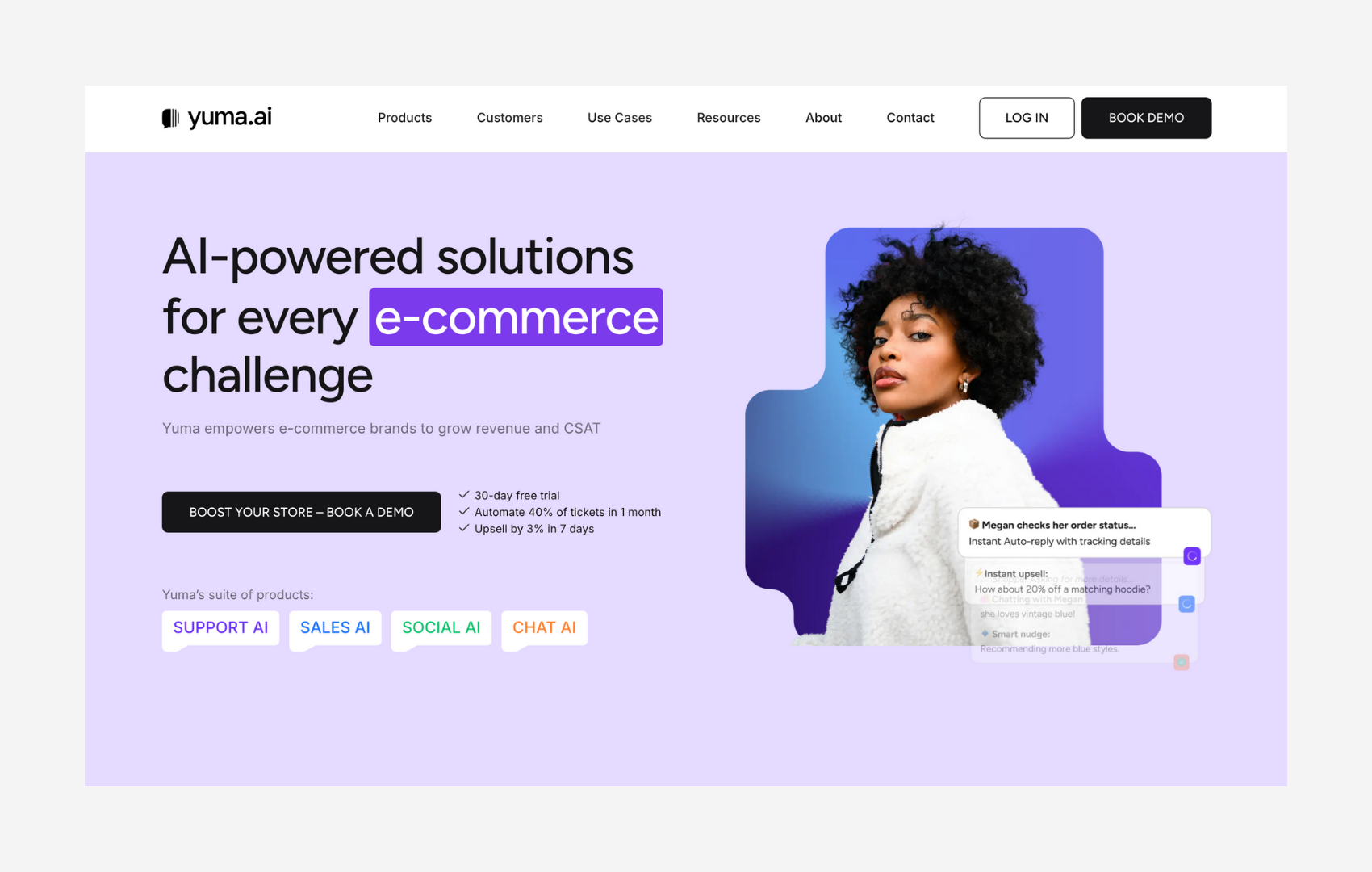
Yuma is an AI support platform designed specifically for ecommerce companies. It plugs into the helpdesk and commerce stack you already use: Shopify, BigCommerce, etc on the commerce side; Zendesk, Gorgias, Kustomer, Re:amaze, Front, etc on the help-desk side. Yuma resolves a large share of tickets end-to-end.
Its agents come built for retail workflows: refunds, exchanges, subscription pauses, order edits, return labels. Yuma can execute those actions directly from the ticket thread.Yuma offers a 30-day free trial to prove value before you commit. That aligns spend with outcomes.
Yuma is ideal for any company that wants high automation without re-platforming. Yuma runs inside your existing helpdesk rather than forcing a system switch, which minimizes change-management and preserves processes.
Generic platforms are suitable across many industries, but they often treat e-commerce specific flows as add-ons. Yuma’s default behaviors assume orders, shipments, and subscriptions, which is why tasks like issuing refunds or editing orders happen inside the support thread without complex setup. Yuma publicly states SOC compliance and references SOC 2 Type II with a live trust-center.
Bottom line is that If your roadmap reads “fast setup, faster answers, no re-platforming,” Yuma is the e-commerce-first option to trial first. Prove value during the 30-day free period, then scale on a pay-for-resolution model.
Yuma AI Top features:
- AI Agents
- Auto-pilots
- Invoice Generator
- Chat AI (AI-native on-site chat)
- Social AI (full social interaction automation)
- Metrics / CX Dashboard
- Package Tracker
- Integrations: Shopify, BigCommerce, Zendesk, Gorgias, Kustomer, Re:amaze, Front.
Pricing + trial:
- Pricing: Performance-based.
- Free trial: 30 days.
2. Zendesk AI (aka Ultimate AI)
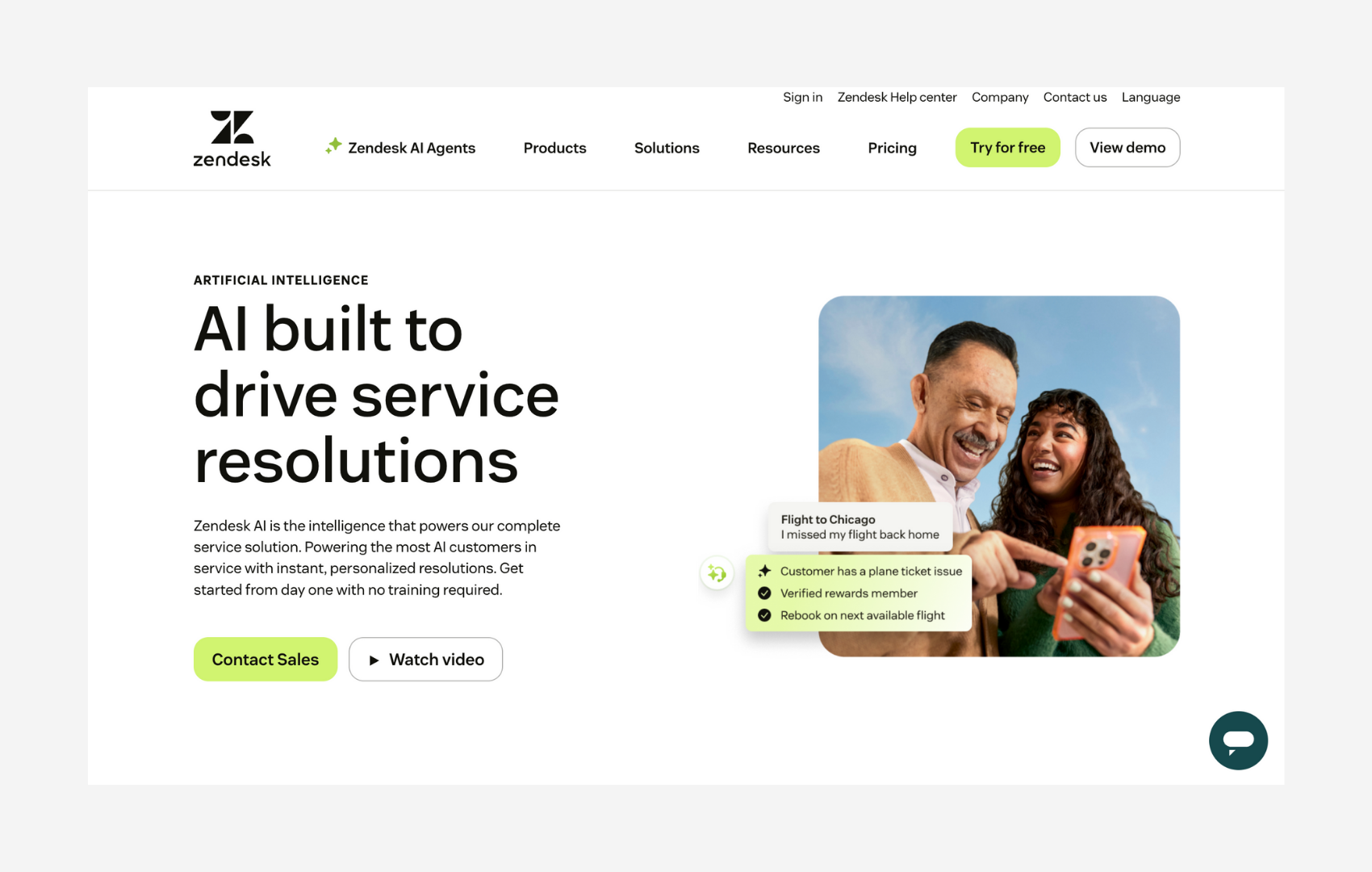
Zendesk AI (aka Ultimate AI) bundles AI Agents for customers and an Agent Copilot for reps, embedded across the broader Zendesk Suite. It’s a strong, general-purpose option.
Zendesk now offers outcome-based pricing for AI agents. So you pay when the bot actually resolves an issue, aligning spend with results. Copilot adds suggested replies, summaries, and knowledge surfacing inside the agent workspace.
While Zendesk is industry-agnostic, the official Shopify integration lets agents view orders and process refunds/cancellations without leaving Zendesk, which makes it practical for retail teams already on the Suite.
Compared with e-commerce-first tools, Zendesk’s strength is breadth—omnichannel ticketing plus AI under one roof. Retail-specific flows are available via integration and configuration rather than as the default product behavior.
Suite plans are publicly listed (e.g., Suite Team per-agent pricing), with AI add-ons and outcome-based options published by Zendesk.
Zendesk AI Top features:
- AI Agents
- Agent Copilot
- AI-based Search (generative)
- Quality Assurance (AutoQA)
Pricing + trial:
- Pricing: Various tiers and ad-ons with outcome based pricing.
- Free trial: 14 days
3. Intercom: Fin AI Agent & Copilot

Intercom pairs a customer-facing Fin AI Agent with Fin AI Copilot for agents, packaged inside its broader helpdesk suite. Fin answers, takes actions, and resolves issues; Copilot drafts and summarizes for reps. It’s a strong, general-purpose option with fast-moving AI releases.
Intercom leans into outcome-based pricing. Fin is $0.99 per automated resolution, with suite seats starting “from $29/mo,” and a 14-day free trial. Recent updates add agentic workflows (Fin Tasks), Model Context Protocol (MCP) action connectors, and expanded analytics.
Good coverage for many merchants, though retail flows are configured via integrations rather than being commerce-native by default like Yuma AI.
Top features:
- Fin AI Agent
- Fin AI Copilot
- Fin Tasks & Data Connectors
Pricing + trial:
- Helpdesk seats from US$29/mo
- Fin AI Agent US$0.99 per resolution
- Free trial: 14 days
4. Freshdesk: Freddy AI
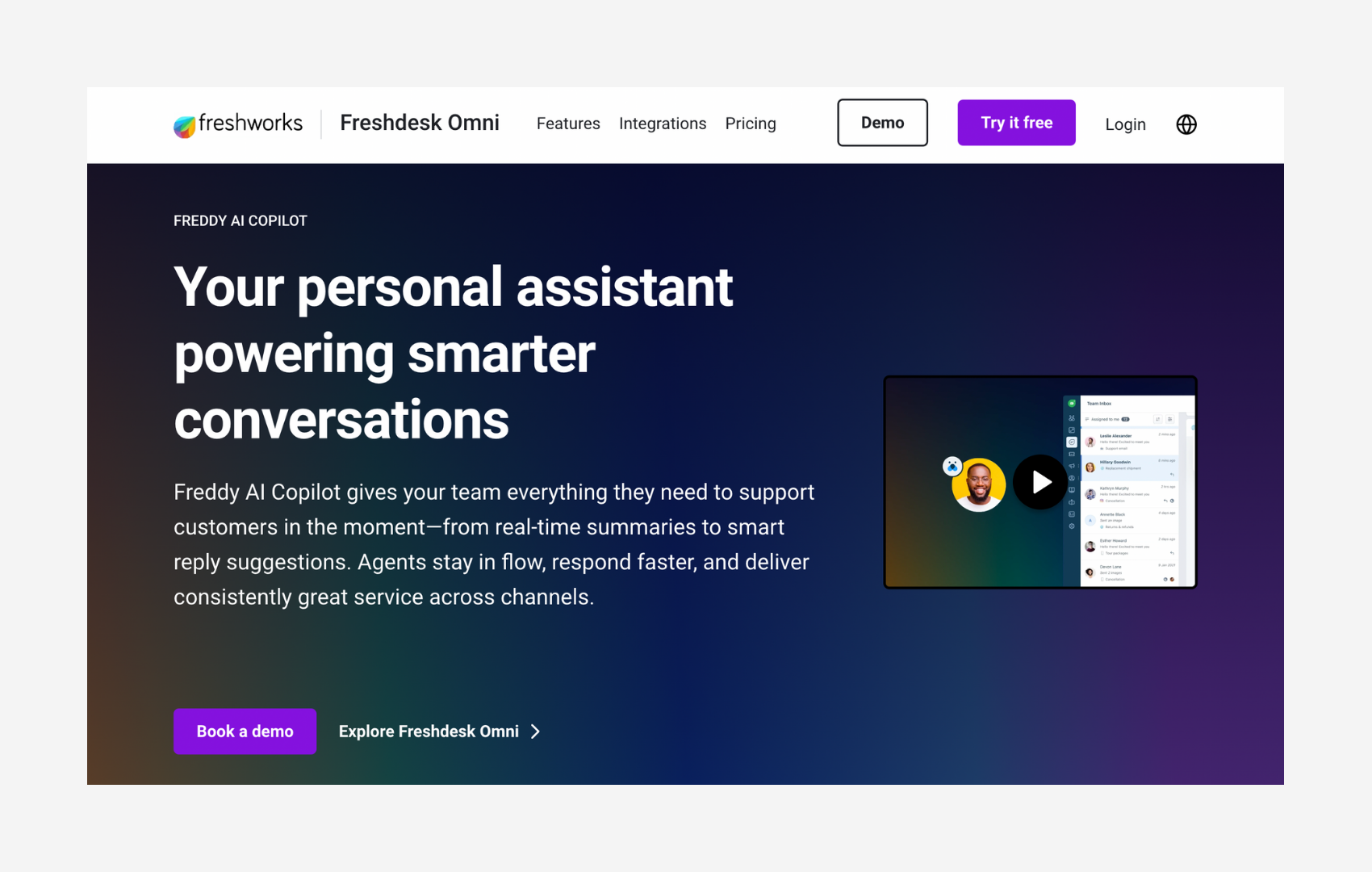
Freshdesk pairs a mature omnichannel helpdesk with two AI layers: Freddy AI Agent for customer-facing automation and Freddy Copilot for agent assist. Agent can tap your back-end systems to process refunds, update orders, verify details, and resolve routine issues automatically, while Copilot drafts replies and surfaces knowledge in the agent workspace. For e-commerce teams, the official Shopify integration lets agents cancel or refund orders directly inside Freshdesk. Useful if you’re already standardized on Freshdesk and want retail actions without leaving the console.
Freshdesk is also clear about pricing mechanics: session-based for the AI Agent and a per-agent add-on for Copilot, with a 14-day free trial to evaluate the stack before rollout.
Top features:
- Freddy AI Agent
- Freddy AI Copilot
- Freddy AI Insights
Pricing + trial:
- AI Agent: US$100 per 1,000 sessions.
- Copilot add-on: from US$29 per agent/month.
- Free trial: 14 days.
5. Gorgias: AI Agent & Automate

Gorgias is a helpdesk with native order actions in the ticket view and an AI Agent that can answer and resolve common requests. Gorgias’s AI Agent currently deploys on Email and Chat (with “more channels to come”), and its knowledge relies heavily on a Help Center.
There’s also a platform limitation worth noting if you’re not on Gorgias. Gorgias AI Agent isn’t supported on Zendesk, Kustomer, or other help-desks.
For brands standardized on Gorgias + Shopify, this tight integration is a strength. If, however, you need AI resolution across more channels today or you’re running a non-Gorgias helpdesk, you’ll want to factor these scope notes into your comparison. Especially when comparing against AI platforms that work inside the helpdesk you already use (e.g., Zendesk, Kustomer, etc) and across multiple commerce stacks.
Top features:
- AI Agent (conversational automation)
- Automate (Flows, Quick Responses, Article Recommendations)
- Shopify actions in-ticket (refund/cancel/create)
Pricing + trial:
- Ticket-based pricing.
- Free trial: 7 days.
6. Salesforce Service Cloud (Agentforce)
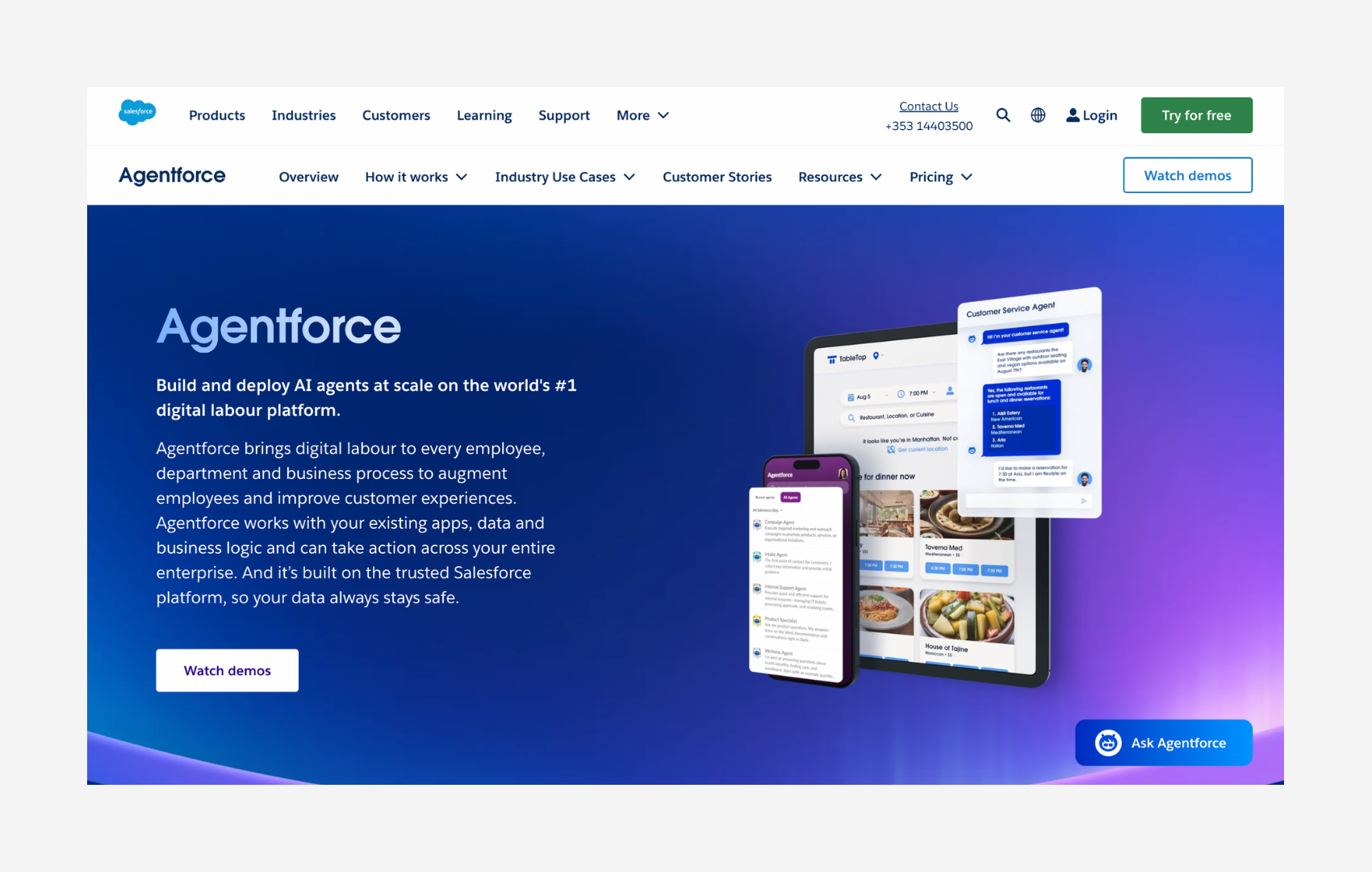
Service Cloud is Salesforce’s core support platform; Agentforce is the built-in AI layer that drafts, routes, and now runs AI agents across channels (email, chat, voice, self-service). Salesforce recently launched Agentforce 3 with a Command Center for governance/observability — useful in big orgs that need control as they scale automation.
Best with Salesforce Commerce/Order Management, their agents can process cancellations, returns, reshipments, and refunds from the console. If you run Shopify or other storefronts, those actions typically rely on AppExchange connectors/partner apps, not native defaults.
Pricing/packaging spans multiple models and add-ons (often quote-driven), and non-Salesforce commerce stacks usually need extra connectors to reach end-to-end order actions. This adds setup complexity that focused e-commerce AI tools don’t require.
Top features:
- Agentforce AI agents & assist
- Command Center (governance/observability)
- Omnichannel console (email, chat, voice, self-service)
Pricing + trial:
- Agentforce add-on: US$125/user/month (billed annually).
- Free trial: 30 days.
7. Ada: AI Customer Service Platform
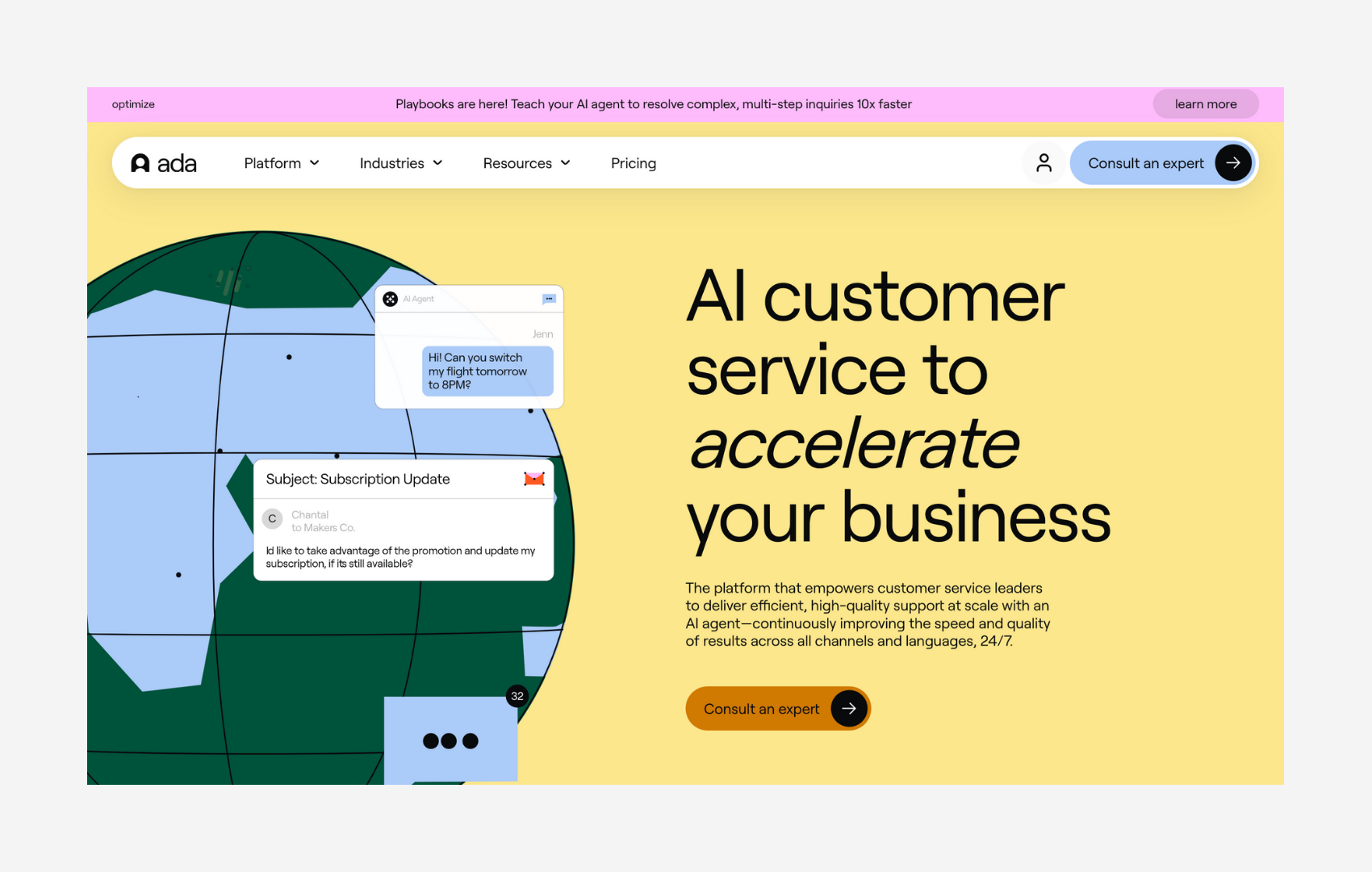
Ada is a cross-industry AI platform that runs customer-facing automation across messaging, voice, and email, with orchestration and governance built in. It’s positioned to resolve large share of routine tickets and hand off cleanly when a human is needed.
Clear focus on usage-based pricing and an “all-included” packaging. Ada also publishes deep integration docs and turnkey integrations so teams can move from pilots to production faster.
Ada offers Shopify integration to look up orders and shipment details and to pull last-order/customer info. For end-to-end commerce actions (e.g., refunds, exchanges), teams typically wire Ada to storefront APIs or use helpdesk integrations, rather than relying on default, commerce-native behaviors.
Top features:
- Messaging, Voice, Email automation
- Secure authentication & personalization
- Proactive outreach triggers
Pricing + trial:
- Pricing: Usage-based
- Free trial: 14-days
8. Kustomer: Kustomer IQ & AI Agents
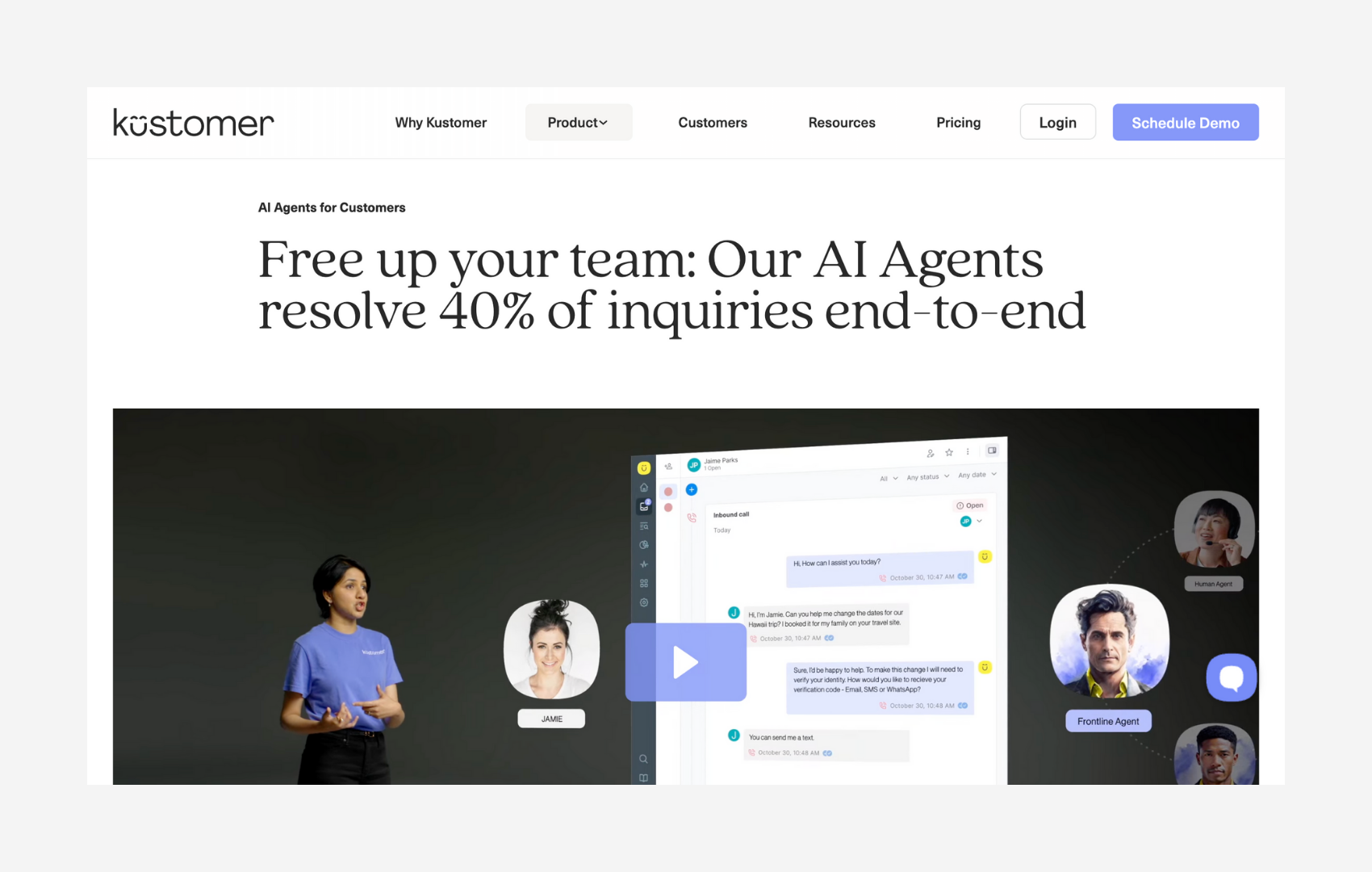
Kustomer is an AI-powered customer-service CRM with AI Agents for customers and agent assist tools built into an omnichannel console (email, chat, SMS, social, voice). Recent product pages emphasize AI Agents operating across channels and a rep-facing automation mode.
The store integrations pull order history into the Kustomer timeline and exposes store actions for agents; Kustomer’s rep-side AI can also trigger actions (e.g. cancel orders) with approval. In practice, end-to-end commerce automations are achievable but typically rely on longer setup — unlike tools that ship e-commerce specific flows as defaults.
Top features:
- AI Agents for Customers
- AI Agents for Reps
- Omnichannel workspace
Pricing + trial:
- Pricing: AI add-ons - AI Agents for Customers from $0.60 per engaged conversation; AI Agents for Reps $40/user/mo.
- Free Trial: 14 days
9. Decagon: Conversational AI Platform
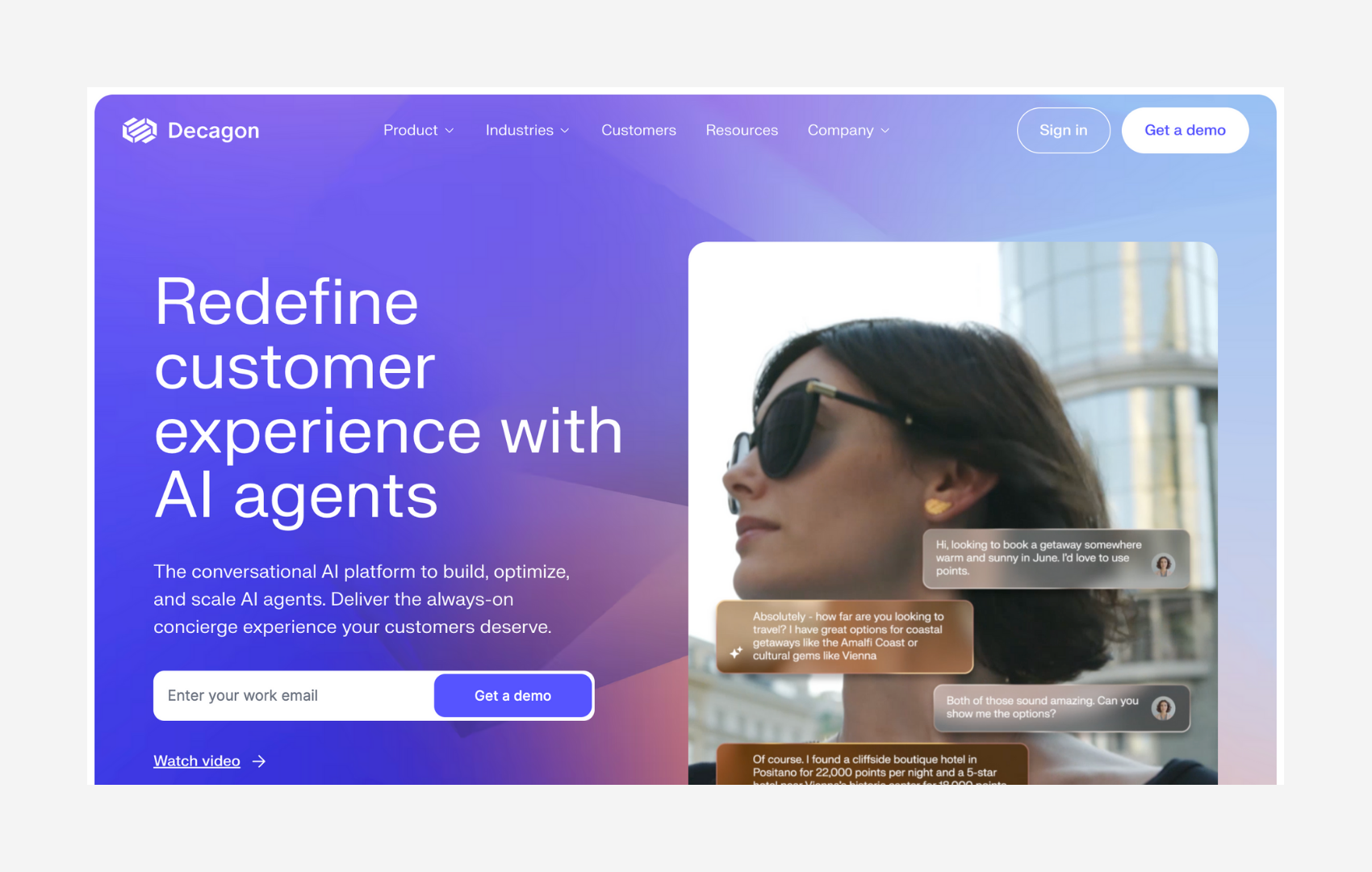
Decagon claims to run one “brain” across chat, email, and voice with guardrails, human handoff, and observability. Aimed at auto-resolving issues while keeping governance tight. Recent materials highlight Voice AI and a centralized engine rather than stitched-together bots.
Decagon offers a Shopify integration and connects to tools like Zendesk, Salesforce, and Stripe; it’s agents that “\integrate with platforms like Shopify can take real action in real time across chat, email, and voice. In practice, reaching full end-to-end flows typically involves wiring the agent into your CRM/helpdesk and internal APIs. The platform’s omnichannel model “one central brain” for voice, chat, and email, keeps logic consistent once those integrations are in place, but it does mean initial outcomes depend on the complexity of the setup.
Top features:
- Agent Operating Procedures (AOPs)
- Omnichannel engine (chat, email, voice)
- Agent Assist
Pricing + trial:
- Pricing: Resolution based
10. Tidio: Lyro AI
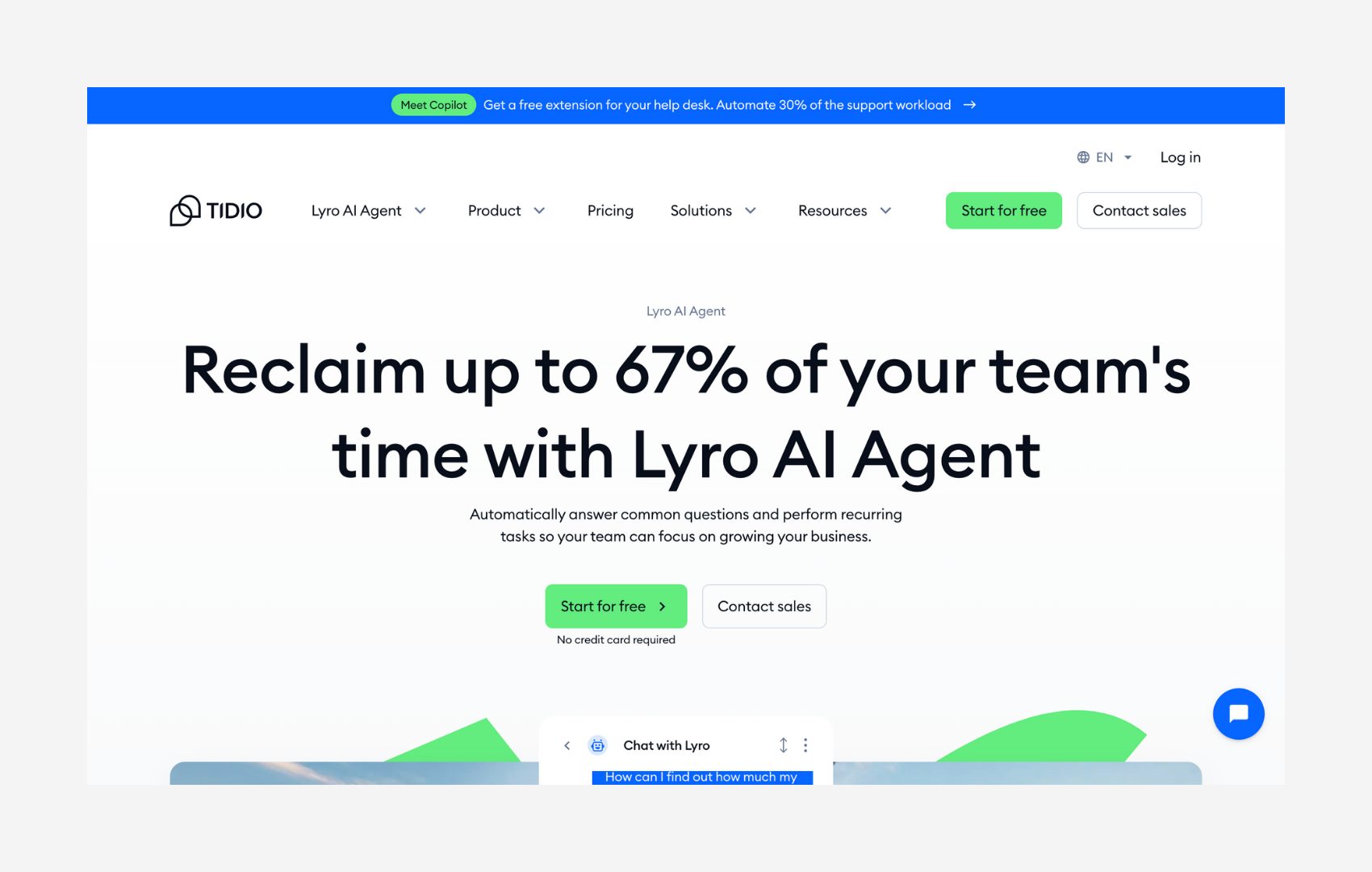
Tidio’s Lyro AI works with live chat and a multichannel inbox, automating common questions across website chat and email. Lyro learns from your support content and can run basic tasks like order-status checks or ticket creation.
Their integrations are quick to install (app listing + free trial) and is popular with SMB stores. Lyro’s autonomy depends on the quality of your knowledge base; Tidio highlights resolution-rate guarantees on higher tiers. If you need out-of-the-box, in-thread commerce actions (e.g., refunds/exchanges) tightly embedded in the helpdesk from day one, an e-commerce-first product typically gets you there faster.
Top features:
- Lyro AI agent
- Live chat & multichannel inbox
- Email automation
Pricing + trial:
- Pricing: Starts at $24.17/mo for the basic plan
- Free trial: 7 days
11. Sierra: Agent OS
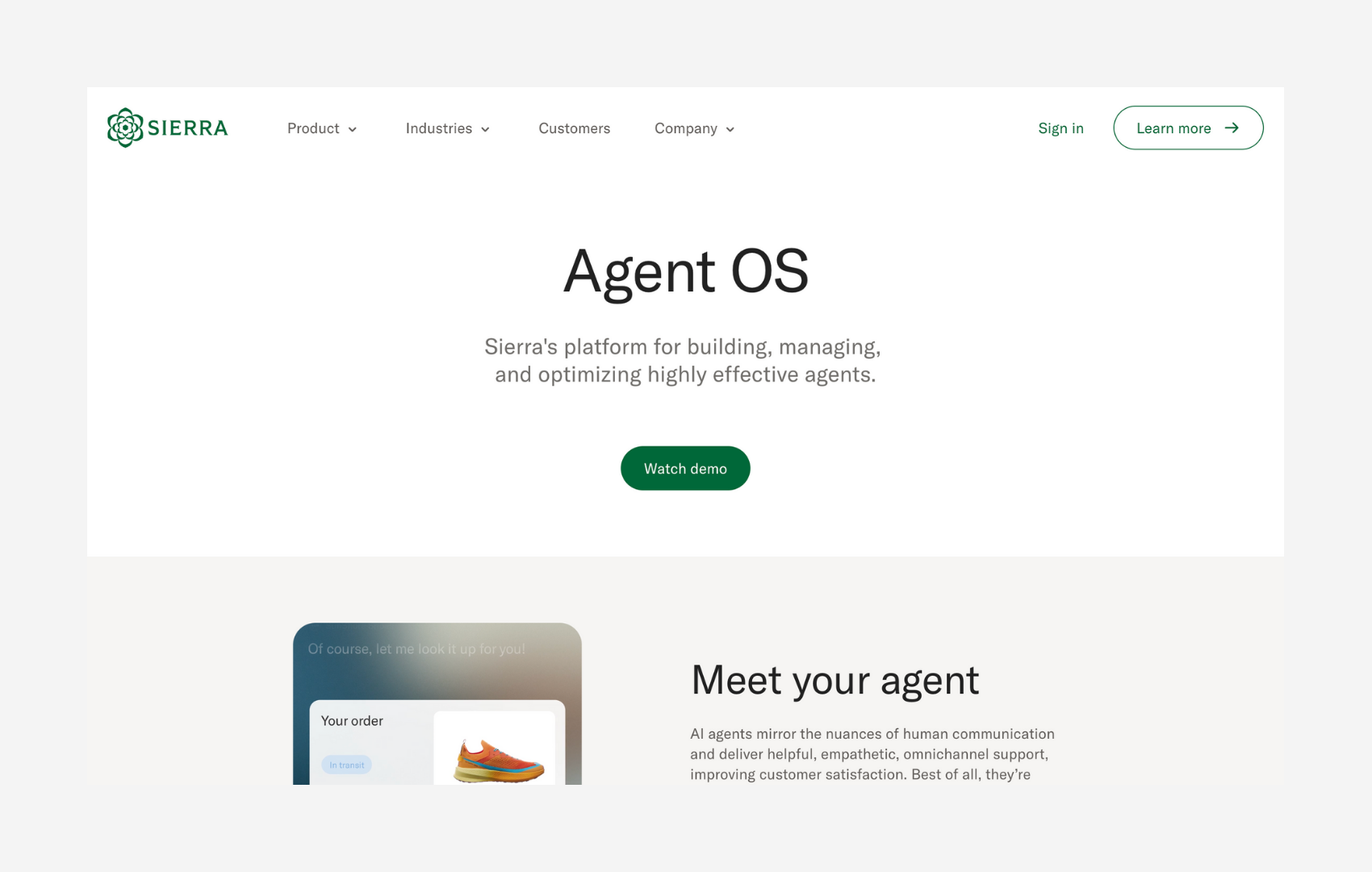
Sierra is a conversational-AI platform for building and governing customer-facing agents across chat, email, and voice. It emphasizes empathetic, on-brand conversations, guardrails, and the ability to take actions in your systems.
Sierra is a generalist AI tool for CX that caters to various industries. They allows pre-purchase guidance and order management flows like track orders, request refunds, convert returns to exchanges, update subscriptions. Sierra brings a robust, general-purpose agent platform with strong voice and governance. If you’re a Shopify/BigCommerce brand prioritizing default, in-thread commerce actions with outcome-aligned billing, Yuma’s e-commerce-first approach typically reaches value faster. According to The complete guide to AI Agent Pricing Models in 2025 - they typically require $50,000 to $200,000 in professional services fees and 3–6 months of implementation time.
Top features:
- Agent OS (build, configure, optimize)
- Omnichannel agents (chat, email, voice)
- Goal/guardrail framework & supervision
Pricing + trial:
- Pricing: Outcome-based pricing
- Free trial: N/A
Comparison Table
Six-Question Diagnostic to find the Perfect Tool
Ask the following 7 questions when considering an AI tool and partner for your customer support in 2025:
1. Can it automate inside your current helpdesk, no re-platforming? (Yuma plugs into Zendesk, Gorgias, Kustomer, etc., and performs these actions from the ticket thread.)
2. Is pricing aligned to outcomes (pay only for fully automated resolutions) with a real trial to prove value? (Yuma uses performance-based pricing and a 30-day free trial so you test before committing.)
3. How fast to first automation on core retail intents (WISMO, returns, cancellations)? Days, weeks or months? (Yuma ships retail defaults and runs in your existing stack, so time-to-impact is in days.)
4.Can you encode policies as guardrails — refund windows by market, exchange eligibility, partial refunds? (Yuma Guidelines let you set policy rules that the agent follows consistently.)
5. Does the AI understand attachments (receipts, labels, PDFs/screenshots) inside the thread and act on them? (Yuma’s Media Brain parses images/PDFs so agents—or the AI—can resolve faster.)
6. Do you get actionable analytics and improvement insights? (Yuma’s Metrics and audit trails make performance reviewable in QBRs and day-to-day ops.)
Decision Matrix (weights you can tune)
Assign 100 points across these criteria based on your context; then score each vendor 1–5 and multiply.
Tip: If you’re a multi-brand Shopify org with frequent returns, bump E-commerce actions to 30–35 and drop Ecosystem fit to 5.
Future Trends to Watch (2025–2026)
1. Voice AI becomes more common
The voice AI market exploded after H2 2024. Dedicated voice agents are now a mainstream support channel with funding and adoption surging. Vendors are shipping voice-first capabilities alongside chat and email; while Andreessen Horowitz calls to expect call containment targets (and QA for transcripts) to enter CX KPIs soon.
2. AI governance becomes part of the product
Enterprises want agents that act, not just draft. Just as important: observability. Companies are launching Command Centers to track, manage, and scale agent behavior. It’s evidence that monitoring, rollback, and policy controls are moving front-and-center.
3. Pay for outcomes, not promises
Outcome-based pricing is crossing the chasm. More and more top companies are charging only for fully automated resolutions. Budget owners will increasingly ask vendors to share risk and proof.
4. Agents need UI, not just text
Commerce is visual and interactive; long bot chats won’t cut it. Shopify’s new MCP UI lets agents return interactive components (product pickers, carts, etc) instead of plain text. This points to a near future where the “chat” becomes the app.
5. Multilingual by default
Real-time translation is becoming table stakes in the inbox and in AI agents, shrinking language gaps for teams overnight. Top tools already offer fully multilingual capabilities making it a standard for the industry.
6. Regulation hardens: disclose the bot, log the actions
EU rules require clear disclosure when people interact with AI and labeling of synthetic content; NIST’s AI RMF gives buyers a ready-made checklist for guardrails, evaluation, and incident response. Expect procurement to ask for audit logs and security parameters.
What this means for you: prioritize platforms that (a) act safely across channels, (b) expose controls and logs, and (c) price against outcomes.
Common FAQs
1. What’s the difference between a chatbot and an AI agent?
A chatbot answers; an AI agent answers and takes actions (e.g., change an order) under guardrails, often orchestrating multi-step workflows across systems.
2. Will AI hurt CSAT?
Not necessarily. A large field study (Oxford Academic) showed +15% productivity and more polite customers with an AI copilot. Evidence that assistance can improve outcomes when designed well.
3. How much “training data” do we need?
Less than you think. Modern tools ground answers in your knowledge base and policies, plus task templates. No model retraining required for most use cases.
4. Can an AI actually issue refunds in Shopify?
Yes, with proper permissions and approvals, AI agents can programmatically create and log refunds with audit trails. Today’s AI agents can perform complex tasks across platforms if set up properly.
5. How do vendors price AI for support?
Different vendors price their tools differently, which is why it’s so important to clarify pricing before adopting a tool. Two common models are outcome-based (pay only when AI resolves) and per-resolution (e.g., $0.99 per resolution).
Conclusion – Rethinking Support
Customer support in 2025 isn’t a choice between speed and empathy. Well-designed AI lets teams do both: automate the repetitive work and reserve human attention for the moments that matter. We opened by defining what these systems actually are—tools that can understand requests and, increasingly, take actions (refunds, exchanges, order edits), not just draft replies. From there, we set a transparent methodology and used it to compare ten credible platforms.
The list reflects two broad camps. E-commerce-first tools like Yuma AI prioritize retail workflows out of the box. These tools issue refunds, edit orders, and resolve intents inside the helpdesk you already use, with outcome-aligned pricing that rewards real automation. Generalist tools like Zendesk AI (aka Ultimate AI), Intercom’s Fin, Salesforce Service Cloud (Agentforce), Freshdesk, etc win on breadth but require complex setup and much more maintenance. Other tools like Gorgias, Ada, Kustomer, Decagon, and SMB-focused Tidio offer strong options depending on your stack, team size, and tolerance for custom setup.
Across vendors, the buying pattern is converging: judge agents by what they can safely do, not how well they word answers; expect governance and audit-ability to be built in; prefer pricing tied to resolved conversations; and assume multilingual support as standard. Our Buyer’s Toolkit distilled these into simple checks so you can compare like-for-like.
If there’s a single takeaway, it’s this: the advantage goes to teams that treat AI like a disciplined experiment. Start with a few high-volume intents, prove end-to-end actions with audit trails, and scale what works. Choose tools that act, not just answer.

.webp)
.webp)
.webp)
.png)












